Cold calls. Everyone gets them, and most people dread them.
So what do you do to make sure that the cold calls you make don’t end up on a dial tone before you can even get your name and company information out of your mouth?
Plenty of things, actually. So keep reading.
What is a cold call?
A cold call is a tool used by a sales representative or a Business Development Specialist to try and make a sale. The call is unsolicited, making it a ‘cold’ call.
Who makes cold calls?
A cold call typically takes place between a sales rep and a company that fits their Ideal Customer Profile (ICP).
What is the goal of a cold call?
The goal of a cold call is typically to book the next meeting.
Yet, cold calls are an uphill battle. According to a study done by the Kenan-Flagler Business School, the cold call success rate is only 2.5 percent. But, does this mean cold calls are dead? Not exactly.
The study used a base of fifty experienced salespeople, following them over two weeks as they went about their jobs. During that period, they made 6,264 cold calls. Seventy-two percent of the calls were immediate rejections, while a further twenty-eight (1,774 of the calls) were considered productive.
A productive cold call is one where the person being approached shows some interest in furthering the conversation. The study actually showed that more of that two-week period was invested in following up with productive calls than in making new ones.
Despite that major time investment, of those 1,774 calls labeled as productive only nineteen of them actually resulted in an appointment being made. The ratio of effort to reward equaled one successful appointment per every seven and a half hours of cold calling.
The moral of this story is that to be successful, you have to really pay attention to how you’re conducting the calls. You also have to be prepared to get shut down more often than not.
How to structure your cold calls
The first thing every sales rep should have in mind is not to trigger sales resistance. When structuring your call, be mindful that the person you are calling is likely as busy as you are and didn't wake up this morning looking forward to scheduling a meeting with you. This means that the first few seconds of your call are vital.
Focusing on the right tonality and pacing at the start of your cold call will help you gain the prospect's attention and interest, instead of coming off as pushy and causing the prospect to put their guard up. Pacing is particularly important because you don’t want to bombard them with information too quickly for them to process. Yet, you also don’t want them to get bored with your small talk as you attempt to create a connection.
Once you have gained the attention of your prospect, don't waste any time. You and your prospect have a common goal — finding out if the subject of your call (your product or service) is worth exploring further. Focus on the most important pieces of information and tailor your pitch to each individual company and prospect.
If the first two parts go well, the last — and perhaps most important part — is booking the actual meeting. Remember, this was the goal from the start. So, instead of giving your prospect options, find a good CTA to close the call. This could be asking them to set up a meeting in the future or securing a time that you can call back to continue the conversation. An example could be: “I will call you tomorrow to tell you more about the offer. Does 3 pm work for you?”
Avoid giving your prospect options from your calendar or asking them when they are available. Your prospect is busy and is likely not going to give you a time. Instead, try giving them a specific time or even better, position the meeting like a natural progression of the conversation that you just had.
For example; “Would it make sense to continue the conversation regarding how we can help you with <XYZ> in a call this week”. In this way, you are not selling the meeting to the prospect but rather focusing on the conversation that you are having.
A 4-step framework for cold calling
Use the below framework as a template for your outreach.
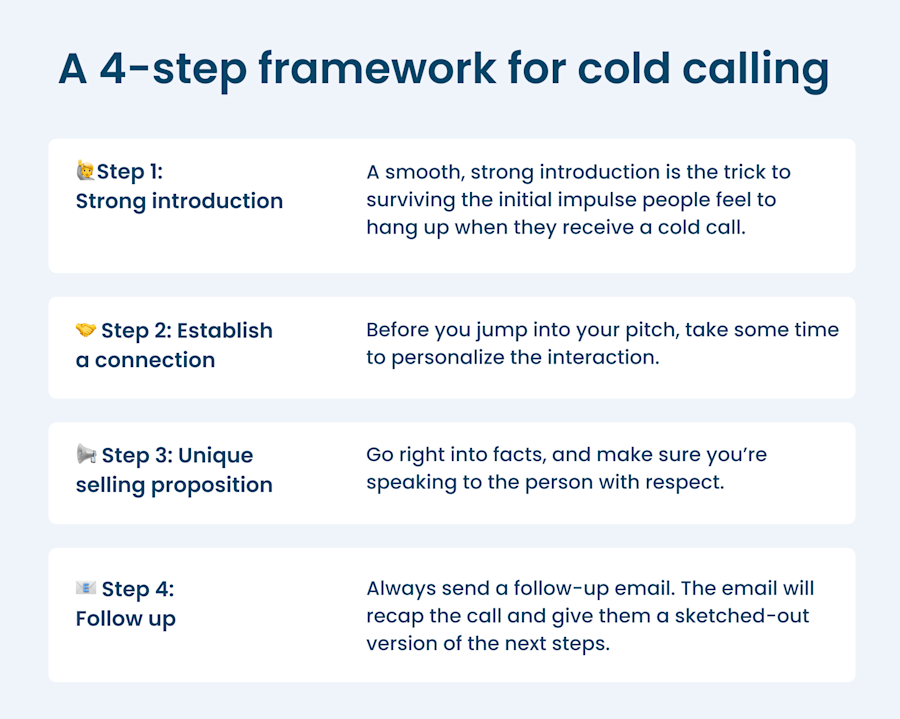
Step 1: Strong introduction
A smooth, strong introduction is the trick to surviving the initial impulse people feel to hang up when they receive a cold call. You want to sound casual and friendly enough not to come off as cold but also to get their attention immediately. This means you need to speak with confidence.
Don’t forget to go slowly enough that the person you’re speaking to actually has time to process what you’re saying!
Step 2: Establish a connection
Before you jump into your pitch, take some time to personalize the interaction. No one wants to feel like they’re just a name on a list that someone is checking off. Keep your tone friendly and open, and inquire into their life.
As marketing experts agree in this Forbes article, a quick Google search (more on that below) can do wonders. You can acknowledge how long they’ve been at their current position or comment on recent happenings with the company they work for. The point of this is to create a bond with them.
Doesn’t everyone want to believe they’re more than just an ICP?
This makes you and them more approachable as you get ready to advance toward the actual point of the call. But, there's another benefit. If the person you’re talking to already feels like you have a connection, it can help you navigate around their inevitable objections.
Remember that your main objective is to keep them on the phone long enough that you capture their curiosity. If it seems like they’re still inclined to hang up at this point, try asking a few finishing questions.
If they reiterate that they’re busy, ask when a better time to call would be.
If the person answering the phone can’t handle your request, get the information of who you should be speaking to from them before you hang up.
If you're speaking to a business and they say that their company isn’t interested, inquire about what kind of needs and priorities the company currently has.
Once the call is over, it’s over — so even if you don’t think you’re going to make an immediate sale, use the time you have wisely!
Step 3: Unique selling proposition
Assuming that your charming small talk and ability to circumvent objections are successful, the person you’re speaking with will want to know why you’re calling.
It's important to be prepared for this transition. Go right into facts, and make sure you’re speaking to the person with respect. You may know about their industry, but you don’t know more than them — or at least, they'll assume you don't. Honor their time and intelligence by avoiding filler that will make them impatient.
You should also continue to pay close attention to their tone. Even once you are into your pitch, there are objections that they could make. Be prepared for those. If they're already working with a competitor, you should already have your script detailing what makes your product better.
Prove to them that you are educated in their industry or company and that you know your product or service is a stronger choice.
It also helps to phrase your questions to them in a way that will evoke a positive response. The more they can answer "yes" to things that you’re asking them, the more momentum will be built between you.
Step 4: Follow up
Once you’ve finished the call and determined that it was productive, you should always send a follow-up email. The email will recap the call and give them a sketched-out version of the next steps.
What to do before the call
If you take some time to prepare, you have a much higher chance of success. Here's what to do before you even make the call.
Do thorough research
Research is the name of the game to personalize your cold-calling strategy. Having a background knowledge of the company and its possible pain points will also set you up for success when acknowledging objections.
Be complimentary toward the company, but avoid praising them too much. If they’re doing that well, then why would they need what you’re offering? Try a sales funnel to make a template that perfectly maps out the customer’s progress and makes adjustments along the way.
Moreover, having sufficient knowledge about the prospect you are calling will enable you to take this one step further. Where did the prospect work before their current positions? Any interest related to the subject of your call? This goes back to establishing a connection.
You can also connect with them in the literal sense. Find the person you’re going to cold call on LinkedIn and other social media channels. If they recognize your name from something like LinkedIn, they’re less likely to immediately hang up on you. Just make sure you’re only following professional accounts.
If you start liking all of the pictures from their most recent trip to Palm Springs, they’ll probably consider that a step (or five) too far.
Stick to an outline
By now, you probably know how these calls go. If not, you’re in the right place.
We recommend sticking to a cheat sheet. An outline or personalized sales script helps you guide the call in the right direction if you end up down a rabbit hole on a certain topic. Think of this as a checklist to follow to nail all of your talking points.
Set up a space conducive to sales
Everyone’s worst nightmare is getting on the call and sharing the wrong screen or having a general tech issue that you could’ve worked out ahead of time. If you’re lucky enough to get someone on the phone, the rest of the call needs to be smooth sailing for the person on the other end.
Do a trial run
Practice is important! Even if you have to talk in the mirror or call your mom, we recommend a trial run. This preparation helps you realize if you don’t know something simple like how to pronounce the company name or the name of the person you’ll be speaking with.
If you feel like you need some real-world practice, you can try video prospecting. The approach and desired result are the same, but you’re allowed multiple takes!
You can also cheat off the person next to you. Listen to your colleague’s sales calls to become familiar with the flow of conversation and to see what works (and what doesn’t).
Acknowledge objections
Objections are inevitable and part of the gig. Cold calling is infamous, and most people are immediately looking for a reason to hang up. To keep the potential buyer on your side, make sure that you listen and validate the objections they have.
It’s important to acknowledge the objection as a valid concern to show the potential prospect that you’re listening and personalizing the experience.
A great tactic for this is labeling the objection. Once they feel like you understand what they’re saying, they’re more likely to have a positive response as you continue the conversation. If they say that they are busy or don’t have time to listen to your pitch, make sure they feel heard.
Reaffirm to them that you understand by rephrasing their objection or labeling the emotion they’re trying to convey. Here are some examples:
I completely understand if you’re busy right now. It sounds like your work keeps you very busy, and that must be exhausting.
Thank you for letting me know that your department doesn’t handle this type of purchase. I don’t want to waste your time, so maybe you can help me figure out the right department?
It’s understandable if you’re worried about not having enough time to schedule a meeting. Your industry seems high-stress and you have a lot on your plate.
You should also have a list of common objections or custom pain points of the company, with counterpoints to put the client at ease.
Timing and trigger events
Time of day is a popular topic amongst salespeople. Are 9-5’ers more likely to pick up the phone on Wednesday or Thursday? Are they morning people or afternoon people?
A study on call centers done by CallHippo in January of 2023 showed that cold calls are most successful on Wednesdays, and the best time to make a cold call is from 11 am to 12 pm. The second best time to call is between 4 pm and 5 pm.
Trigger events are specific events that can change how receptive the potential customer will be to you. This is part of doing your research beforehand; if you are familiar with a company, you can be aware of when a trigger point is on the horizon.
These are things like an acquisition, a new enterprise client, hiring a bunch of people, firing a bunch of people, funding, etc. When a trigger event happens, a company is usually in a position where change is already happening and therefore open to even further change.
You can easily track trigger events by setting up a CRM integration to alert you to specific keywords. The CRM can deliver the updates to whatever platform is most convenient for you, ensuring that you never miss a pivotal opportunity.
Cold calling tips
Have you done your research? Practiced your pitch a few times? Is your script right in front of you and ready to go? Congrats — you’re ready for the big leagues.
Lead with your goal
Similarly to the preparation recommended above, sticking to an outline will help you accomplish your goal. Always steer the conversation back toward the task at hand, whether that’s booking another meeting or getting the name of the decision maker.
Use open-ended questions
It’s a pretty solid rule of thumb in the sales world to use open-ended questions on cold calls, and most sales calls generally. This keeps the flow of conversation going between both people and prevents awkward pauses.
The person will also feel like you were really interested in their problems and how to solve them instead of just pushing your solution — this is exactly the impression you want to give.
Focus on them
Like the point above, focus on them. Most people are inherently selfish and want to be the center of attention. A member of our customer success team said, “they might not remember you or your solution, but they’ll remember how they felt on the call”. Making the call about them is a sure way to create a good sentiment.
Be aware of tonality
To start, be yourself. This point is just to ensure that you’re also self-aware. If the person is stressed out, use a calming tone. If they’re bored, be excited about the product. You get it.
Listen
This one is a given. Feeling heard builds the trust needed to further a relationship.
5 cold call pitches that hit
Pitch 1
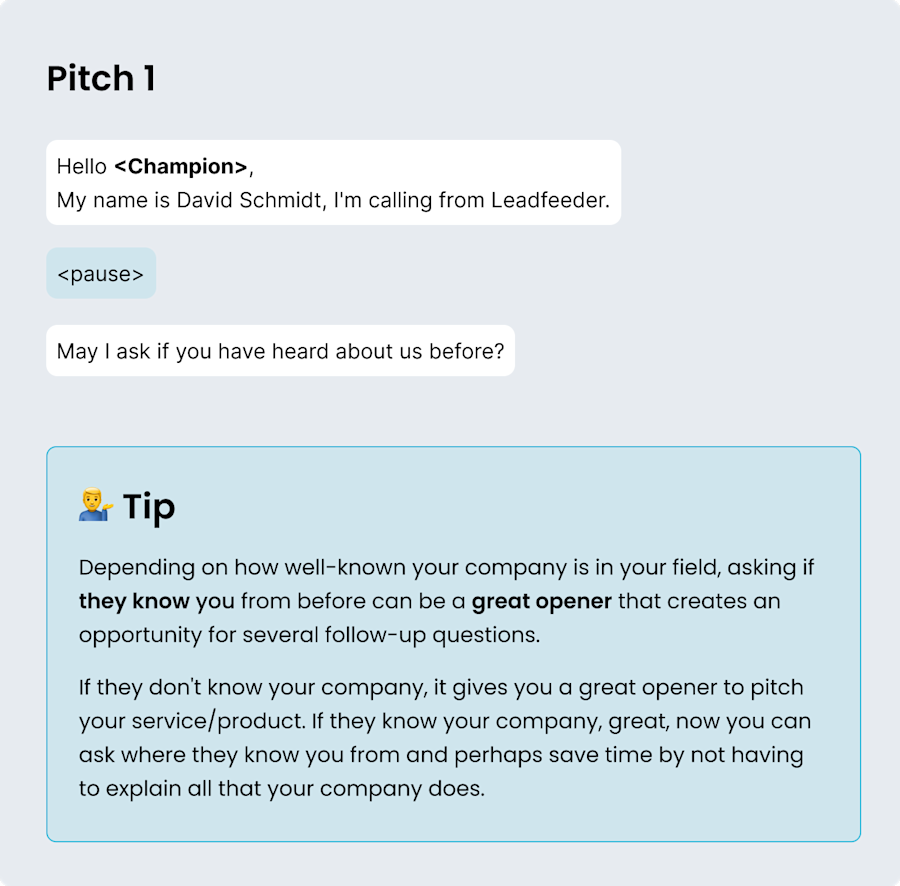
Pitch 2
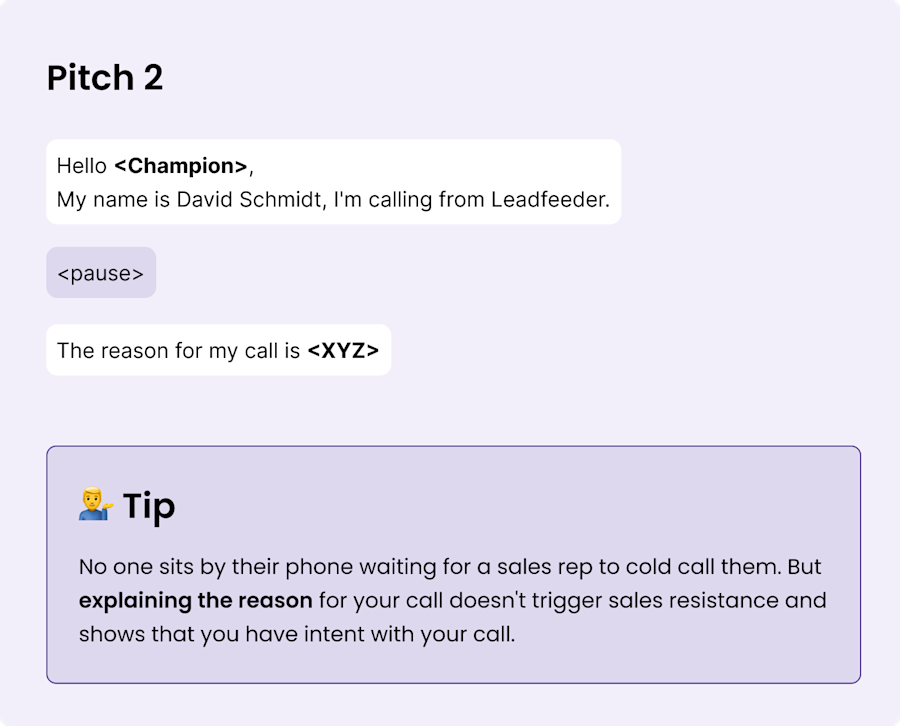
Pitch 3
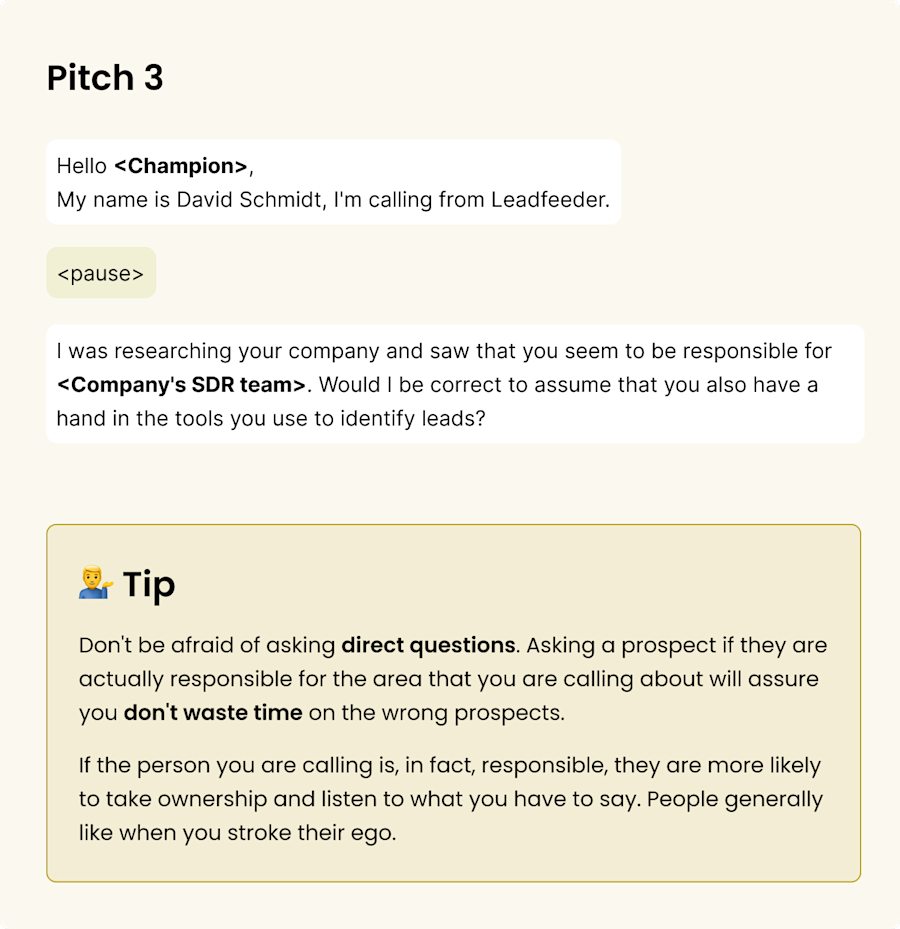
Pitch 4
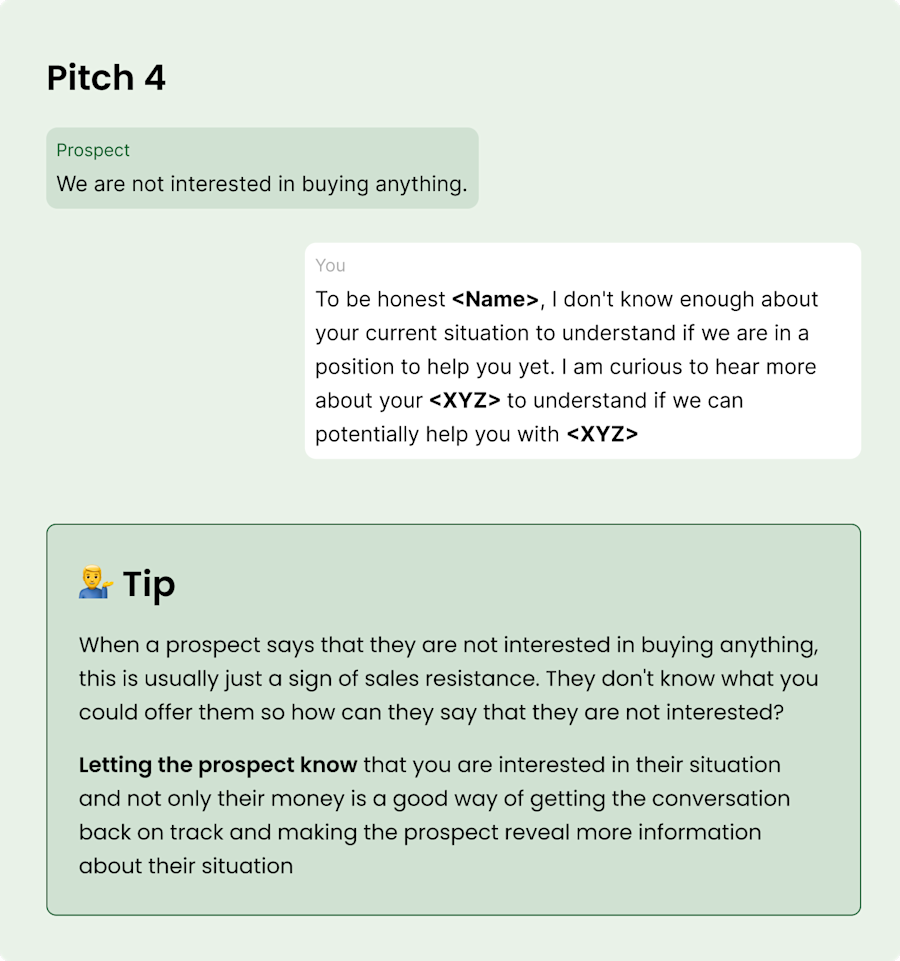
Pitch 5
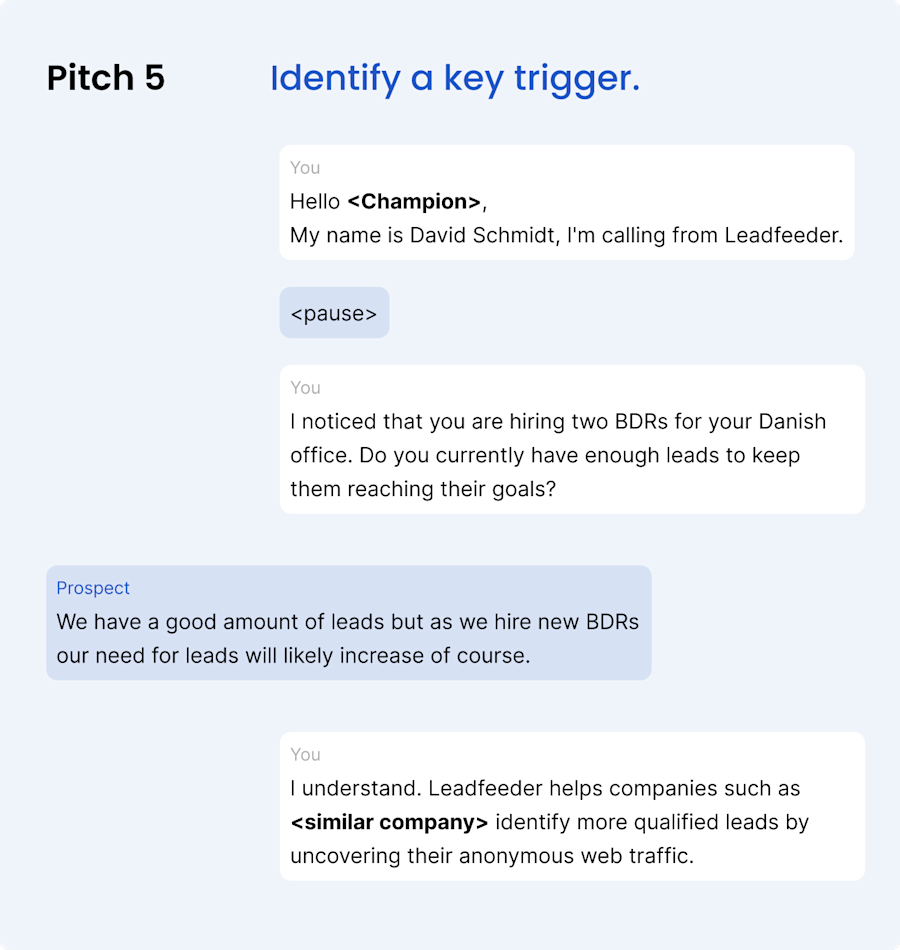
The Takeaway
Cold calls aren’t a tactic that will win every time. You may have to put in a few hours and endure a few hang-ups before it pays off, but there are ways to improve your odds. Doing your research beforehand, establishing a connection right away, and using a smart script like the ones above will give you the best shot possible. Good luck!
Now that you're here
Leadfeeder is a tool that shows you companies that visit your website. Leadfeeder generates new leads, offers insight on your customers and can help you increase your marketing ROI.
If you liked this blog post, you'll probably love Leadfeeder, too.
Sign up




